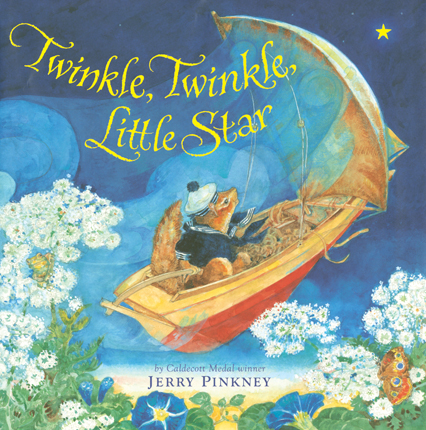Full Text Reviews: Booklist - 10/01/2011 *Starred Review* The song Twinkle, Twinkle, Little Star provides lines of text for this imaginative picture book, in which a little chipmunk emerges from the safety of its burrow to discover the natural world. Since the story begins in daylight, the first starlike sights seen are white blossoms, dandelion fluffs, and drops of water on a spider’s web. As night falls, the chipmunk climbs into a birds’ nest that transforms into a little boat and sails into the night sky. The final picture shows the chipmunk at home asleep. From cover to endpapers, every element in the book contributes to the dreamlike vision of a curious adventurer exploring the natural world. This appropriate theme for young children finds expression in a series of vividly imagined, gracefully composed, and beautifully detailed illustrations, created using pencil, watercolors, and colored pencils. While the appended artist’s note states that the lyrics were selected from public-domain versions of the song, Jane Taylor, who in 1806 published most of the lyrics used here, is mentioned only in the book’s Library of Congress Cataloging-in-Publication data. Inspired by the familiar song but not limited by literal interpretation, this evocative picture book offers a rewarding reading experience at bedtime, or any time. - Copyright 2011 Booklist. School Library Journal - 11/01/2011 PreS-Gr 1—In his latest re-imagining of a childhood classic, Pinkney focuses on the wonderment of a chipmunk. The endpapers, which open at sunrise and conclude with starlight, signal the time frame. The inquisitive creature's quest to understand both what and where stars are (verses alternate at appropriate junctures) begins from the safety of his cozy nest. As time passes he discovers the shape in natural phenomena ranging from star-imprinted morning glories and the dew on a spider web to flickering fireflies and the gleam in a swan's eye. His actions become progressively more daring: seeing a robin's nest in the tree, he ascends. The home subtly transforms into a boat, he into a sailor, soaring through the heavens, borne on the breath of an animated wind, then gently deposited on a water lily for a final adventure. Employing pencil, watercolor, and colored pencil, the artist skillfully captures the chipmunk in a host of poses and expressions, building a character worthy of visiting again and again. An opulent blue winds through Pinkney's dazzling compositions, providing depth, unity, and pure pleasure. This world is so full of interest that scenes break the frames of small panels and full bleeds until the conclusion, when circular compositions provide security. Nods to other lullabies, a subplot, and music are smoothly incorporated. Illuminating notes discuss how the notion of a lullaby serving as a bridge from a child's safe haven to the unknown dream world inform Pinkney's telling. A stellar performance from a book-making virtuoso.—Wendy Lukehart, Washington DC Public Library - Copyright 2011 Publishers Weekly, Library Journal and/or School Library Journal used with permission. Bulletin for the Center... - 12/01/2011 A chipmunk explores both the real world and a dream world in Pinkney’s illustrated version of the popular lullaby. A dandelion seed “star” sparks the chipmunk’s curiosity (“How I wonder what you are!”) and he follows its path, observing other natural objects-flowers, dewdrops, and fireflies-along the way. As evening falls, the chipmunk finds an empty robin’s nest and, in a dream sequence, uses it as a boat to sail away into the sky where actual stars and the moon are seen. The chipmunk’s boat then tips him out, and he falls onto a lily pad where he spies a white water lily before being jostled into the water by a fish. Luckily, he is rescued by a white swan, who flies him up to the moon, while the last page shows him asleep in his own nest. While there is a pleasant sense of end-of-day wind-down to the book, it’s rather confusing and muddled, both in concept and illustratively. The connection between the dandelion fluff (and the other natural objects) and the “star” of the lullaby lyrics is a shaky one, and that and the abrupt leap from realism to fantasy will go over the heads of young audiences. The warm, naturalistic detail of Pinkney’s art (in pencil, watercolor, and colored pencil) will appeal to nature-lovers, and his chipmunk is a fetching little guy. Some of the dense spreads are hard to read visually, especially when the chipmunk is placed against a background of a similar color value. Adults could certainly use this as a bedtime or storytime book, but it might be more successful and enjoyable without the text. There’s oddly no mention of Ann and Jane Taylor, the authors of the original poem, anywhere in the book, but a detailed note does explain Pinkney’s artistic and adaptive decisions. JH - Copyright 2011 The Board of Trustees of the University of Illinois. Loading...
|



